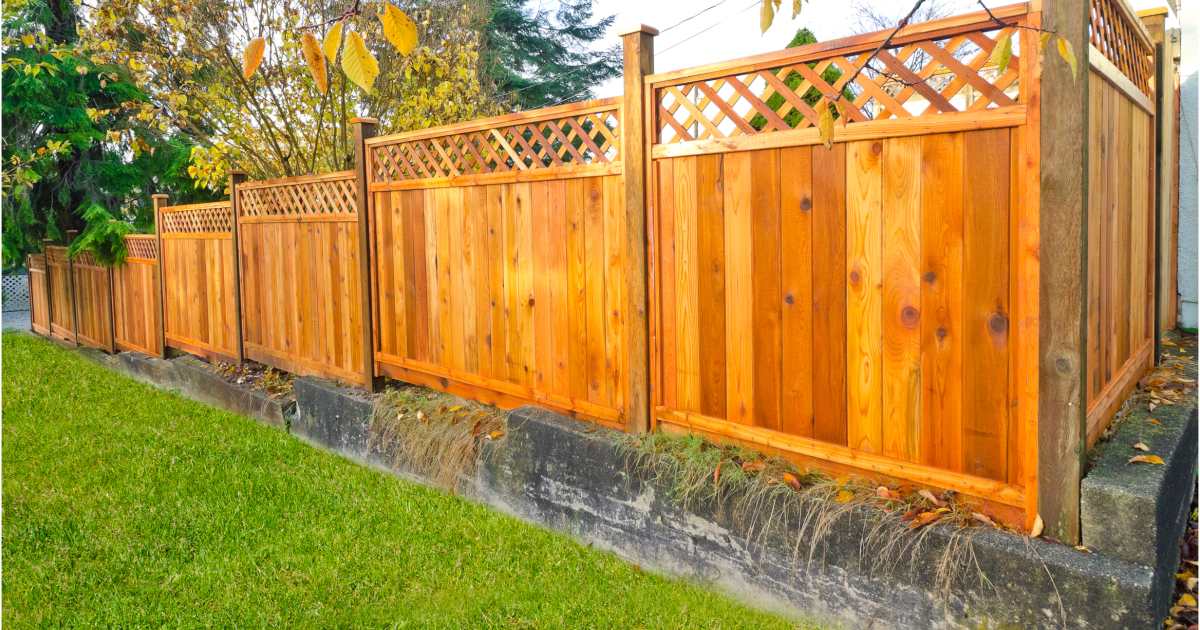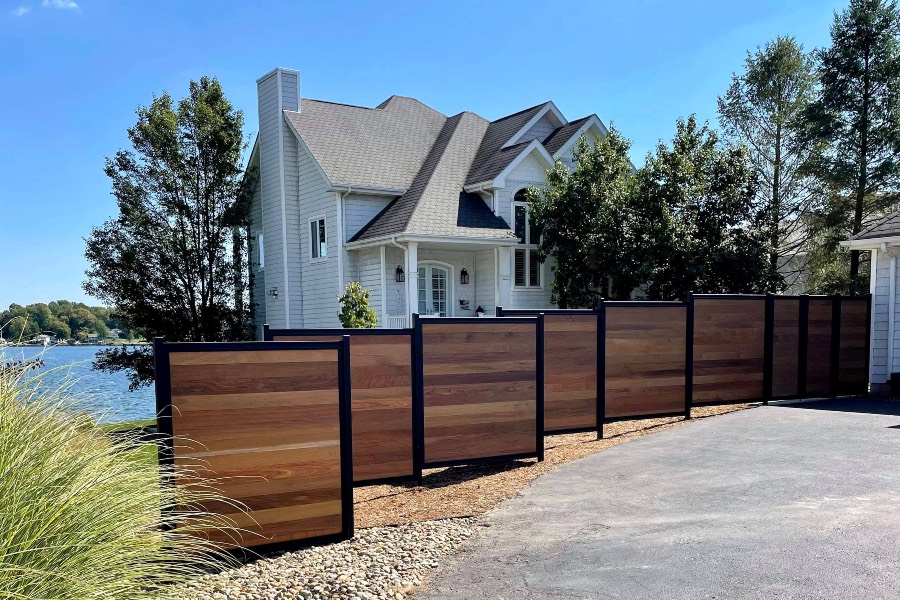All Categories
Featured
Your fencing is a financial investment that supplies curb, privacy, and security appeal. Each secure fencing kind has distinct upkeep needs based on its product's toughness, exposure to the elements, and other factors.
![]()
Weather Condition Protection: Use a high-grade sealer or stain every 2-- 3 years to safeguard the timber from wetness and UV rays. For severe environments, annual reapplication may be required. Cleansing: Make use of a garden hose pipe or a pressure washing machine on a low setting to get rid of dust and mildew. Adhere to up with a moderate cleaning agent for stubborn discolorations. Repairs: Examine for loose or decaying boards and replace them immediately. Tighten nails or screws to maintain the structure stable. Bug Control: Usage termite-resistant timber or treat the fencing with parasite repellents to prevent problems. 2. Vinyl Fencings. Vinyl fencings are popular for their sturdiness and very little upkeep demands.
Cleaning: Wash the surface area with a garden hose or a mix of soap and water to eliminate dust and algae. For difficult spots, use a soft-bristle brush or a vinyl-specific cleaner. Assessments: Regularly evaluate for splits or bending, especially after hefty effects or solid winds. Repair work: Replace any busted areas promptly. Plastic fencings often make use of modular parts, making fixings straightforward. 3. Chain-Link Fences. Chain-link fences are tough and cost-efficient but require regular interest to prevent corrosion.
Rust Removal: Make use of a cord brush to get rid of corrosion from subjected locations, after that apply a rust-inhibiting spray to secure the steel. Cleansing: Hose down the fence consistently to remove dust. For gunk, usage soapy water and a stiff-bristle brush. Repair work: Tighten up any type of drooping areas or change damaged links to maintain security. 4. Wrought Iron Fences. Wrought iron fences use resilience and beauty yet are vulnerable to rust otherwise appropriately maintained.
![]()
Corrosion Prevention: Remove corrosion areas with sandpaper and use a rust-resistant primer followed by exterior metal paint. Inspect for rust at the very least two times a year. Cleaning: Clean down with a cloth and soapy water to preserve the finish. Prevent abrasive cleansers that can damage the surface. Repainting: Paint every few years to shield the steel from corrosion and maintain it looking fresh. 5. Light weight aluminum Fences. Aluminum fences are light-weight, resilient, and immune to corrosion, calling for less maintenance compared to wrought iron.
Cleaning: Clean with soap and water to remove dust and dirt. Wash thoroughly to protect against residue. Assessments: Look for loosened hardware or dents, especially after storms. Secure or change components as required. Touch-Ups: Use paint to scraped or chipped locations to stop damages to the safety finishing. 6. Composite Fences. Compound fences are made from a blend of timber and plastic, integrating longevity with marginal maintenance.
![]()
Cleansing: Make use of a hose pipe or a soft brush with soap and water to clean up the surface. Avoid utilizing severe chemicals. Examinations: Seek warping, specifically in severe heat. Tighten or replace any kind of damaged panels. Mold Avoidance: While composite materials stand up to rot, maintain the fence tidy and dry to prevent mold and mildew build-up. 7. Bamboo Fences. Bamboo is an environment-friendly option however requires cautious upkeep to preserve its appearance and long life.
Sealing: Use a protective sealant or varnish every 2-- 3 years to safeguard versus moisture and UV damage. Cleaning: Clean with mild soap and a soft sponge or brush. Prevent high-pressure cleaning, which can harm bamboo fibers. Repair work: Replace harmed areas or posts to preserve architectural honesty and appearance. General Upkeep Tips for All Fence Kind. Routine Examinations: Check your fence at the very least as soon as every season for damage, wear, or loosened parts. Cutting Plants: Keep bushes, vines, and plants away from the fence to avoid dampness damages and minimize insect task. Seasonal Modifications: In areas with snow, stay clear of stacking snow against your fencing to avoid structural anxiety. In warm environments, evaluate for heat-related warping or fading. Verdict. Each fence product has its special upkeep requirements, but an aggressive method to care can extend its life-span and maintain it looking its best. Wooden fences need more attention compared to vinyl or aluminum, yet each material take advantage of regular cleaning, examinations, and timely fixings. By tailoring your maintenance practices to the kind of fence you possess, you'll make certain that it proceeds to give personal privacy, protection, and curb charm for several years to come.

- Wooden Fences. Wood fencings are valued for their natural appearance but need regular maintenance to avoid damage.
Weather Condition Protection: Use a high-grade sealer or stain every 2-- 3 years to safeguard the timber from wetness and UV rays. For severe environments, annual reapplication may be required. Cleansing: Make use of a garden hose pipe or a pressure washing machine on a low setting to get rid of dust and mildew. Adhere to up with a moderate cleaning agent for stubborn discolorations. Repairs: Examine for loose or decaying boards and replace them immediately. Tighten nails or screws to maintain the structure stable. Bug Control: Usage termite-resistant timber or treat the fencing with parasite repellents to prevent problems. 2. Vinyl Fencings. Vinyl fencings are popular for their sturdiness and very little upkeep demands.
Cleaning: Wash the surface area with a garden hose or a mix of soap and water to eliminate dust and algae. For difficult spots, use a soft-bristle brush or a vinyl-specific cleaner. Assessments: Regularly evaluate for splits or bending, especially after hefty effects or solid winds. Repair work: Replace any busted areas promptly. Plastic fencings often make use of modular parts, making fixings straightforward. 3. Chain-Link Fences. Chain-link fences are tough and cost-efficient but require regular interest to prevent corrosion.
Rust Removal: Make use of a cord brush to get rid of corrosion from subjected locations, after that apply a rust-inhibiting spray to secure the steel. Cleansing: Hose down the fence consistently to remove dust. For gunk, usage soapy water and a stiff-bristle brush. Repair work: Tighten up any type of drooping areas or change damaged links to maintain security. 4. Wrought Iron Fences. Wrought iron fences use resilience and beauty yet are vulnerable to rust otherwise appropriately maintained.

Corrosion Prevention: Remove corrosion areas with sandpaper and use a rust-resistant primer followed by exterior metal paint. Inspect for rust at the very least two times a year. Cleaning: Clean down with a cloth and soapy water to preserve the finish. Prevent abrasive cleansers that can damage the surface. Repainting: Paint every few years to shield the steel from corrosion and maintain it looking fresh. 5. Light weight aluminum Fences. Aluminum fences are light-weight, resilient, and immune to corrosion, calling for less maintenance compared to wrought iron.
Cleaning: Clean with soap and water to remove dust and dirt. Wash thoroughly to protect against residue. Assessments: Look for loosened hardware or dents, especially after storms. Secure or change components as required. Touch-Ups: Use paint to scraped or chipped locations to stop damages to the safety finishing. 6. Composite Fences. Compound fences are made from a blend of timber and plastic, integrating longevity with marginal maintenance.

Cleansing: Make use of a hose pipe or a soft brush with soap and water to clean up the surface. Avoid utilizing severe chemicals. Examinations: Seek warping, specifically in severe heat. Tighten or replace any kind of damaged panels. Mold Avoidance: While composite materials stand up to rot, maintain the fence tidy and dry to prevent mold and mildew build-up. 7. Bamboo Fences. Bamboo is an environment-friendly option however requires cautious upkeep to preserve its appearance and long life.
Sealing: Use a protective sealant or varnish every 2-- 3 years to safeguard versus moisture and UV damage. Cleaning: Clean with mild soap and a soft sponge or brush. Prevent high-pressure cleaning, which can harm bamboo fibers. Repair work: Replace harmed areas or posts to preserve architectural honesty and appearance. General Upkeep Tips for All Fence Kind. Routine Examinations: Check your fence at the very least as soon as every season for damage, wear, or loosened parts. Cutting Plants: Keep bushes, vines, and plants away from the fence to avoid dampness damages and minimize insect task. Seasonal Modifications: In areas with snow, stay clear of stacking snow against your fencing to avoid structural anxiety. In warm environments, evaluate for heat-related warping or fading. Verdict. Each fence product has its special upkeep requirements, but an aggressive method to care can extend its life-span and maintain it looking its best. Wooden fences need more attention compared to vinyl or aluminum, yet each material take advantage of regular cleaning, examinations, and timely fixings. By tailoring your maintenance practices to the kind of fence you possess, you'll make certain that it proceeds to give personal privacy, protection, and curb charm for several years to come.
Latest Posts
Which Furnishings Products Are Finest for Resilience and Design?
Published Jan 19, 25
0 min read
Full Circle Marketing: Where Results Drive Success
Published Jan 19, 25
2 min read
Your Neighborhood Auto Repair Shop for Reliable Service
Published Jan 19, 25
1 min read